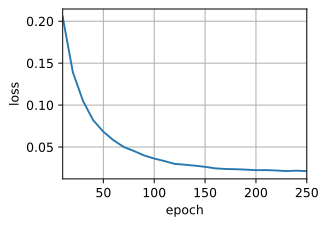一、动机
- 机器翻译时,每个生成的词可能相关于源句子中不同的词
二、Bahdanau 注意力
我们在seq2seq中研究了机器翻译问题,在那里我们设计了一个基于两个循环神经网络的编码器-解码器架构,用于顺序到序列的学习。具体来说,循环神经网络编码器将可变长度序列转换为固定形状的上下文变量,然后循环神经网络解码器根据生成的标记和上下文变量按标记生成输出(目标)序列标记。但是,即使并非所有输入(源)标记都对解码某个标记都有用,但在每个解码步骤中仍使用编码整个输入序列的相同上下文变量。
在为给定文本序列生成手写的一个单独但相关的挑战中,格雷夫斯设计了一种可区分的注意力模型,将文本字符与更长的笔迹对齐,其中对齐方式仅向一个方向移动 Graves.2013。受学习对齐想法的启发,Bahdanau 等人提出了一个没有严格的单向对齐限制Bahdanau.Cho.Bengio.2014 的可区分注意力模型。在预测标记时,如果不是所有输入标记都相关,模型将仅对齐(或参与)输入序列中与当前预测相关的部分。这是通过将上下文变量视为注意力集中的输出来实现的。
模型
在下面描述 Bahdanau 注意力对循环神经网络编码器的关注时,我们将遵循seq2seq 中的相同符号。新的基于注意的模型与seq2seq 中的模型相同,只不过seq2seq_s_t 中的上下文变量 c \mathbf{c} c 在任何解码时间步骤 t ′ t' t′ 都会被 c t ′ \mathbf{c}_{t'} ct′ 替换。假设输入序列中有 T T T 个标记,解码时间步长 t ′ t' t′ 的上下文变量是注意力集中的输出:
c t ′ = ∑ t = 1 T α ( s t ′ − 1 , h t ) h t , \mathbf{c}_{t'} = \sum_{t=1}^T \alpha(\mathbf{s}_{t' - 1}, \mathbf{h}_t) \mathbf{h}_t, ct′=t=1∑Tα(st′−1,ht)ht,
其中,时间步骤 t ′ − 1 t' - 1 t′−1 时的解码器隐藏状态 s t ′ − 1 \mathbf{s}_{t' - 1} st′−1 是查询,编码器隐藏状态 h t \mathbf{h}_t ht 既是键,也是值,注意权重 α \alpha α 是使用加法注意力评分函数计算的。
与seq2seq 中的基础循环神经网络编码器-解码器架构略有不同,下图描述了 Bahdanau 注意力的架构。

- 编码器对每次词的输出作为key和value(他们是等价的)
- 解码器RNN对上一个词的输出是query
- 注意力的输出和下一个词的词嵌入合并进入Recurrent layer
1. 定义Attention解码器
要用 Bahdanau 注意力实现循环神经网络编码器-解码器,我们只需重新定义解码器即可。为了更方便地显示学习的注意力权重,以下 AttentionDecoder 类定义了具有注意机制的解码器的基本接口。
import torch
from torch import nn
from d2l import torch as d2l
class AttentionDecoder(d2l.Decoder):
"""The base attention-based decoder interface"""
def __init__(self,**kwargs):
super(AttentionDecoder,self).__init__(**kwargs)
@property
def attention_weight(self):
raise NotImplementedError
现在让我们在接下来的 Seq2SeqAttentionDecoder 类中以 Bahdanau 注意力实现循环神经网络解码器。初始化解码器的状态
-
编码器在所有时间步长的最终层隐藏状态(作为注意力的键和值);
扫描二维码关注公众号,回复: 14810574 查看本文章
-
最后一个时间步长的编码器全层隐藏状态(初始化解码器的隐藏状态);
-
编码器有效长度(排除在注意力池中填充标记)。
在每个解码时间步骤中,解码器上一个时间步的最终层隐藏状态将用作关注的查询。因此,注意力输出和输入嵌入都连接为循环神经网络解码器的输入。
class Seq2SeqAttentionDecoder(AttentionDecoder):
def __init__(self,vocab_size,embed_size,num_hiddens,num_layers,dropout=0,**kwargs):
super(Seq2SeqAttentionDecoder,self).__init__(**kwargs)
self.attention = d2l.AdditiveAttention(num_hiddens, num_hiddens,num_hiddens, dropout) # 与seq2seq相比多了这一个
self.embedding = nn.Embedding(vocab_size,embed_size)
self.rnn = nn.GRU(embed_size + num_hiddens, num_hiddens, num_layers,dropout=dropout)
self.dense = nn.Linear(num_hiddens, vocab_size)
def init_state(self,enc_outputs,enc_valid_lens,*args):
# Shape of `outputs`: (`num_steps`, `batch_size`, `num_hiddens`).
# Shape of `hidden_state[0]`: (`num_layers`, `batch_size`,
# `num_hiddens`)
outputs,hidden_state = enc_outputs
return (outputs.permute(1,0,2),hidden_state,enc_valid_lens)
def forward(self, X, state):
# Shape of `enc_outputs`: (`batch_size`, `num_steps`, `num_hiddens`).
# Shape of `hidden_state[0]`: (`num_layers`, `batch_size`,
# `num_hiddens`)
enc_outputs, hidden_state, enc_valid_lens = state
# Shape of the output `X`: (`num_steps`, `batch_size`, `embed_size`)
X = self.embedding(X).permute(1, 0, 2)
outputs, self._attention_weights = [], []
for x in X:
# Shape of `query`: (`batch_size`, 1, `num_hiddens`)
query = torch.unsqueeze(hidden_state[-1], dim=1)
# Shape of `context`: (`batch_size`, 1, `num_hiddens`)
context = self.attention(query, enc_outputs, enc_outputs,enc_valid_lens)
# Concatenate on the feature dimension
x = torch.cat((context, torch.unsqueeze(x, dim=1)), dim=-1)
# Reshape `x` as (1, `batch_size`, `embed_size` + `num_hiddens`)
out, hidden_state = self.rnn(x.permute(1, 0, 2), hidden_state)
outputs.append(out)
self._attention_weights.append(self.attention.attention_weights)
# After fully-connected layer transformation, shape of `outputs`:
# (`num_steps`, `batch_size`, `vocab_size`)
outputs = self.dense(torch.cat(outputs, dim=0))
return outputs.permute(1, 0, 2), [
enc_outputs, hidden_state, enc_valid_lens]
@property
def attention_weights(self):
return self._attention_weights
使用包含7个时间步长和4个序列输入地小批量测试我们实现的Bahdanau注意力解码器
encoder = d2l.Seq2SeqEncoder(vocab_size=10, embed_size=8, num_hiddens=16,num_layers=2)
encoder.eval()
decoder = Seq2SeqAttentionDecoder(vocab_size=10, embed_size=8, num_hiddens=16,num_layers=2)
decoder.eval()
X = torch.zeros((4, 7), dtype=torch.long) # (`batch_size`, `num_steps`)
state = decoder.init_state(encoder(X), None)
output, state = decoder(X, state)
output.shape, len(state), state[0].shape, len(state[1]), state[1][0].shape
(torch.Size([4, 7, 10]), 3, torch.Size([4, 7, 16]), 2, torch.Size([4, 16]))
2. 训练
指定超参数,实例化一个 Bahdanau 注意力编码器和解码器,并对这个模型进行机器翻译训练。由于新增的注意力机制,这项训练要比没有注意力机制慢得多。
embed_size, num_hiddens, num_layers, dropout = 32, 32, 2, 0.1
batch_size, num_steps = 64, 10
lr, num_epochs, device = 0.005, 250, d2l.try_gpu()
train_iter, src_vocab, tgt_vocab = d2l.load_data_nmt(batch_size, num_steps)
encoder = d2l.Seq2SeqEncoder(len(src_vocab), embed_size, num_hiddens,
num_layers, dropout)
decoder = Seq2SeqAttentionDecoder(len(tgt_vocab), embed_size, num_hiddens,
num_layers, dropout)
net = d2l.EncoderDecoder(encoder, decoder)
d2l.train_seq2seq(net, train_iter, lr, num_epochs, tgt_vocab, device)
loss 0.021, 10055.2 tokens/sec on cuda:0

3. 使用BLEU评估
engs = ['go .', "i lost .", 'he\'s calm .', 'i\'m home .']
fras = ['va !', 'j\'ai perdu .', 'il est calme .', 'je suis chez moi .']
for eng, fra in zip(engs, fras):
translation, dec_attention_weight_seq = d2l.predict_seq2seq(
net, eng, src_vocab, tgt_vocab, num_steps, device, True)
print(f'{
eng} => {
translation}, ',
f'bleu {
d2l.bleu(translation, fra, k=2):.3f}')
go . => va !, bleu 1.000
i lost . => j'ai perdu ., bleu 1.000
he's calm . => il est paresseux ., bleu 0.658
i'm home . => je suis chez moi ., bleu 1.000
4. 可视化权重
attention_weights = torch.cat(
[step[0][0][0] for step in dec_attention_weight_seq], 0).reshape(
(1, 1, -1, num_steps))
# Plus one to include the end-of-sequence token
d2l.show_heatmaps(
attention_weights[:, :, :, :len(engs[-1].split()) + 1].cpu(),
xlabel='Key posistions', ylabel='Query posistions')

总结
- seq2seq中通过隐状态在编码器和解码器之中传递信息
- 注意力机制可以根据解码器RNN的输出来匹配到合适的编码器RNN的输出来更有效地传递信息